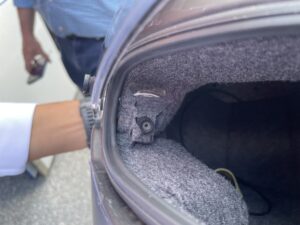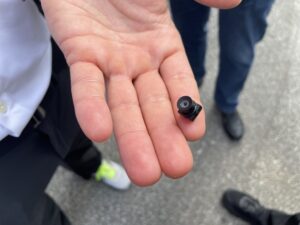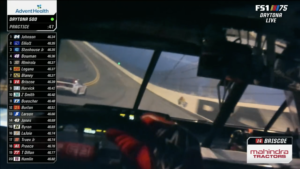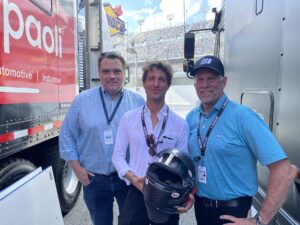Live From Daytona 500: Racing Force Group Brings Driver’s Eye Technology to the NASCAR Circuit
Replacing Visor Cam, the lightweight camera is integrated into certain helmets
Story Highlights
After years of airing driver POVs from Visor Cam, Fox Sports and NASCAR recruited Racing Force Group to implement Driver’s Eye technology in a trio of cockpits in the field of Sunday’s Daytona 500. Also deployed for broadcasts throughout the week leading up to the showcase race, the lightweight, 1.4-gram camera provides a more authentic viewing experience for fans and is tightly integrated into the driver’s helmet for minimal obstruction.
“We’ll have three for this weekend, but we’re looking to build this out every week,” said Mike Davies, SVP, technical and field operations, Fox Sports, prior to the Daytona 500. “Normally, we’d have only one or two Visor Cams [in the past], so this is already an improvement.”

Racing Force Group’s Driver’s Eye camera is located at eye level on the right side of the helmet.
Motorsports Background: Racing Force Group Cut Its Teeth on Formula 1
Racing Force Group began its journey into sports with partnerships with two brands synonymous with motorsports: OMP and Bell. A third company, Zero Noise, provided an electronics background and completed the portfolio.
Based in Italy, Racing Force Group has an extensive presence on the European motorsports scene. As broadcasters of the various racing disciplines searched for a way to improve driver POVs on live productions, the company made a push to optimize the product by combining two research and development centers: Zero Noise for technology and Bell for helmets.
“We started by asking ourselves where we could put a camera to provide the desired view,” says Alexandros Haristos, COO, Racing Force Group. “We ended up with the solution by working backwards. We knew that the camera had to be a certain size while also being under a certain weight, and we created the smallest micro camera in the world for live broadcasting.”

The Driver’s Eye micro camera weighs only 1.4 grams.
The most recognizable name on an international level on their list: Formula 1. Tapped by the sport’s governing body, the Fédération Internationale de l’Automobile (FIA), Racing Force Group supplied Driver’s Eye technology for the 2022 season. Both longtime viewers and first-time fans of Formula 1 noticed the inclusion of the new camera angle on videos right away. Whether it was seeing the streets of Monaco through the visor of Ferrari’s Charles Leclerc or hitching a ride along with two-time world champion Fernando Alonso during first practice for the Japanese Grand Prix in Suzuka, viewers got a sampling of what the innovation can offer.
Vantage Point: Showcasing What It’s Truly Like in the Cockpit
Looking to improve the wearable technology, NASCAR VP, Operations and Technical Production, Steve Stum was impressed with Racing Force Group’s work in Formula 1 — and the way the technology addresses a potential safety concern with Visor Cam.
“Visor Cam was a great view that showed the drivers bouncing around in the car, but it turned into a safety issue,” he explains. “We saw what [Racing Force] did in F1, and moving the camera down a couple of inches made a world of difference.”

The view via Driver’s Eye from inside the car of No. 14 Chase Briscoe
For the Daytona 500 and other NASCAR Cup Series races, the Driver’s Eye setup integrates the micro camera on the right side of the helmet’s padding to ensure a vantage point at the center of the car. On the left side of the helmet, the camera’s non-intrusive cable will connect to a Broadcast Sports International (BSI) RF transmitter inside the car.
From a visual perspective, a delicate dance balanced too much blur against not enough on the outgoing video feed. For any other form of television, video stabilization and picture clarity are two priorities, but highlighting the violent jostling that drivers experience and presenting an imperfect video feed is part of telling the full and accurate story of NASCAR.
“There always needs to be a compromise,” notes Haristos, “but the purpose of Driver’s Eye is to give a very raw view of what is happening. We can use different optics and lenses, but we figured out that, by playing with the angle, we could also play a little bit with the stabilization.” The camera is currently positioned at a 120-degree angle.
One challenge that came with transitioning Driver’s Eye from Formula 1 to NASCAR has a lot to do with the model of each car. In Formula 1, the driver is exposed to open air without a windshield and is covered only by the protective halo positioned overhead. In NASCAR, the cockpit is enclosed by a roof and surrounded by other technologies, such as in-car cameras. In addition, different lighting conditions due to the roof and to night races’ taking place under bright stadium lights increased the challenge for Racing Force Group.

From left: Mike Davies, Alexandros Haristos, and Steve Stum with a Driver’s Eye helmet
“It’s difficult to work from the inside of the helmet because you’re already starting from a very underexposed situation,” adds Haristos. “On the outside, you’re dealing with overexposure from the sun and reflections. We had to come up with a different type of compromise to offset these lighting issues from both inside and outside of the car.”
End Goal: NASCAR Hopes To Homogenize New Helmet Tech
Early in NASCAR’s first full season with Driver’s Eye, results are already exceeding expectations, and Stum and his team have set their sights on expanding its use.
“We’re working on homologating the helmets and getting continued safety approval for more installs,” he says. “We also have multiple styles of helmets, so we’re close to getting them all [on board]. When we eventually make that jump, we’ll make it mandatory that, if a broadcaster asks for it, drivers will have to wear it in the future.”
Even though it is already being included as a key camera angle in NASCAR coverage, Haristos will continue to tinker with and troubleshoot Driver’s Eye as the season goes on. The next task on his list is to refine exposure by embedding an HDR workflow into the camera sensor.
“We’ll be able to manage the exposures at the same time by syncing the two frames together,” he says. “We’re going to roll it out this year, and NASCAR is certainly going to be a stage on which we will try to make the image better.”
